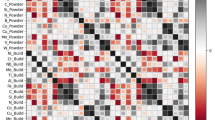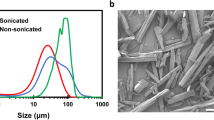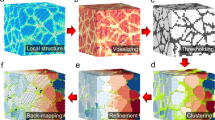Abstract
We present work on the application of sequential supervised machine learning for a reduced-dimension, ballistic deposition, Monte Carlo particle packing. Calculations are carried out for a combination of three distinguishable hard spheres representing different materials. Each set of spheres has a distribution of particle sizes in order to mimic realistic milling conditions of raw ingredients. Since infinite combinations of particle size, distribution, fraction, and density exist, we employ machine learning to aid in the design optimization of new high packing density mixtures. Previously calculated binary packs of particle radius ratios of 80:1 were analyzed, but this work highlights results of ternary packs with radius ratios greater than 300:1. We demonstrate a sequential learning approach where iterative experiments are performed based on minimizing the uncertainty in the target regime of high packing density. New candidate mixtures are identified via classification rather than regression which provides superior ability to extrapolate into high packing density mixtures.








Similar content being viewed by others

References
Elsner P, Eyerer P, Hubner C, Geibler E (1999) The importance of micromechanical phenomena in energetic materials. Propellants Explos Pyrotech 24(1):119–125
Jackson TL, Hegab A, Kochevets S, Buckmaster J (2001) Random packs and their use in modeling heterogeneous solid propellant combustion. J Propuls Powder 17(4):883–891
Hatch RL, Lee Davis I (2006) Mechanical properties for an arbitrary arrangement of rigid spherical particles embedded in an elastic matrix. Defense Technical Information Center, p 69
Coelho D, Thovert JF, Adler PM (1997) Geometrical and transport properties of random packings of spheres and aspherical particles. Phys Rev E 55(2):1959
Kim K, Munakata T (2003) Glass transition of hard sphere systems: molecular dynamics and density functional theory. Phys Rev E 68(2):021502
Donev A, Cisse I, Sachs D, Variano EA, Stillinger FH, Connelly R, Torquato S, Chaikin PM (2004) Improving the density of jammed disordered packings using ellipsoids. Science 303(5660):990–993
Ohern CS, Silbert LE, Liu AJ, Nagel SR (2003) Jamming at zero temperature and zero applied stress: the epitome of disorder. Phys Rev E 68(1):011306
Matheson AJ (1974) Computation of a random packing of hard spheres. J Phys C Solid State Phys 7(15):2569
Visscher WM, Bolsterli M (1972) Random packing of equal and unequal spheres in two and three dimensions. Nature 239(5374):504–507
Jodrey WS, Tory EM (1985) Computer simulation of close random packing of equal spheres. Phys Rev A 32(4):2347
Tobochnik J, Chapin PM (1988) Monte Carlo simulation of hard spheres near random closest packing using spherical boundary conditions. J Chem Phys 88(9):5824–5830
He D, Ekere NN, Cai L (1999) Computer simulation of random packing of unequal particles. Phys Rev E 60(6):7098
Oern CS, Langer SA, Liu AJ, Nagel SR (2002) Random packings of frictionless particles. Phys Rev Lett 88(7):075507
Lubachevsky BD, Stillinger FH (1990) Geometric properties of random disk packings. J Stat Phys 60(5–6):561–583
Lubachevsky BD, Stillinger FH, Pinson E (1991) Disks vs. spheres: contrasting properties of random packings. J Stat Phys 64(3–4):501–524
Webb MD, Lee Davis I (2006) Random particle packing with large particle size variations using reduced-dimension algorithms. Powder Technol 167(1):10–19
McGeary RK (1961) Mechanical packing of spherical particles. J Am Ceram Soc 44(10):513–522
Hugill HR, Westman AER (1930) The packing of particles. J Am Ceram Soc 13(10):767–779
Walton SF, White HE (1937) Particle packing and particle shape. J Am Ceram Soc 20:155–166
Furnas CC (1931) Mathematical relations for beds of broken solids of maximum density. Ind Eng Chem 23(9):1052–1058
Scott GD (1960) Packing of spheres. Nature 188:908
Mason J, Bernal JD (1960) Co-ordination of randomly packed spheres. Nature 188:190
Berryman JG (1983) Random close packing of hard spheres and disks. Phys Rev 27(2):1053–1061
Tory EM, Jodery WS (1991) Computer simulation of close random packing of equal spheres. Phys Rev 32(4):2347–2351
Lee DI (1970) Packing spheres and its effect on the viscosity of suspensions. Paint Technol 42:579
van Lingen JNJ, Ingenhut BLJ, ten Cate AT, Maalderink HH, Straathof MH, van Driel CA (2019) Development of propellant compositions for vat photopolymerization additive manufacturing. Propellants Explos Pyrotech 44:1–18
Parry M, Rizvi Z, Couper S, Lin F, Miyagi L, Spark TD, Brgoch J, Tehrani AM, Oliynyk AO (2018) Machine learning directed search for ultraincompressible, superhard materials. J Am Chem Soc 140(31):9844–9853
Vazquez A, Kauwe SK, Graser J, Sparks TD (2018) Machine learning prediction of heat capacity for solid inorganics. Integr Mater Manuf Innov 7:43–651
Belviso F et al (2019) Viewpoint: atomic-scale design protocols toward energy, electronic, catalysis, and sensing applications. Inorg Chem 58:14939–14980
Kauwe SK, Welker T, Sparks TD (2020) Extracting knowledge from DFT: experimental band gap predictions through ensemble learning. Integr Mater Manuf Innov 9(3):213–220
Murdock RJ, Kauwe SK, Yang AY-T, Sparks TD (2020) Is domain knowledge necessary for machine learning materials properties? Integr Mater Manuf Innov 9:221–227
Gaultois MW, Oliynyk AO, Mar A, Sparks TD, Mulholland GJ, Meredig B (2016) Perspective: web-based machine learning models for real-time screening of thermoelectric materials properties. Appl Mater 4(5):053213
Sparks TD, Gaultois MW, Oliynyk A, Brgoch J, Meredig B (2016) Data mining our way to the next generation of thermoelectrics. Scr Mater 111:10–15
Al AO, Oliynyk EA (2016) High-throughput machine-learning-driven synthesis of full-Heusler compounds. Chem Mater 20:7324–7331
Graser J, Kauwe SK, Sparks TD (2018) Machine learning and energy minimization approaches for crystal structure predictions: a review and new horizons. Chem Mater 30(11):3601–3612
Hall J (2021) Particle packing machine learning code. https://doi.org/10.5281/zenodo.5132822
Kim SB, Park CH (2015) Sequential random k-nearest neighbor feature selection for high-dimensional data. Expert Syst Appl 42:2336–2342
Edali M, Yucel G (2019) Exploring the behavior space of agent-based simulation models using random forest metamodels and sequential sampling. Simul Model Pract Theory 92:62–81
Kauwe SK, Graser J, Murdock R, Sparks TD (2020) Can machine learning find extraordinary materials? Comput Mater Sci 174:109498
Acknowledgements
The authors gratefully acknowledge support from the NSF CAREER Award DMR 1651668.
Author information
Authors and Affiliations
Corresponding author
Ethics declarations
Conflict of interest
On behalf of all authors, the corresponding author states that there is no conflict of interest.
Rights and permissions
About this article
Cite this article
Hall, J.R., Kauwe, S.K. & Sparks, T.D. Sequential Machine Learning Applications of Particle Packing with Large Size Variations. Integr Mater Manuf Innov 10, 559–567 (2021). https://doi.org/10.1007/s40192-021-00230-7
Received:
Accepted:
Published:
Issue Date:
DOI: https://doi.org/10.1007/s40192-021-00230-7



